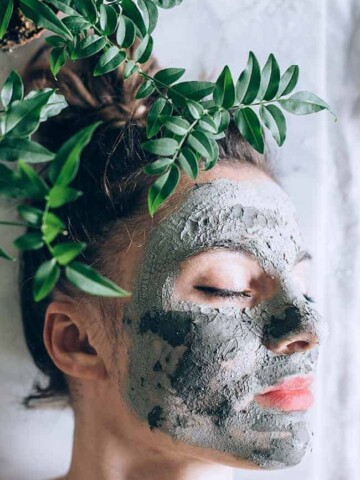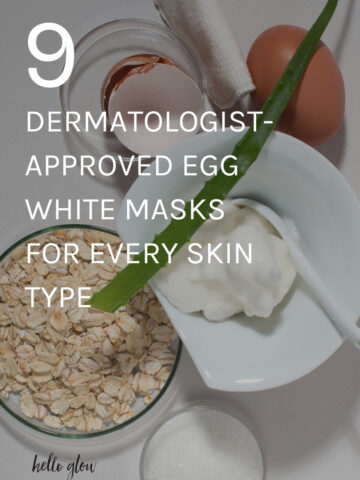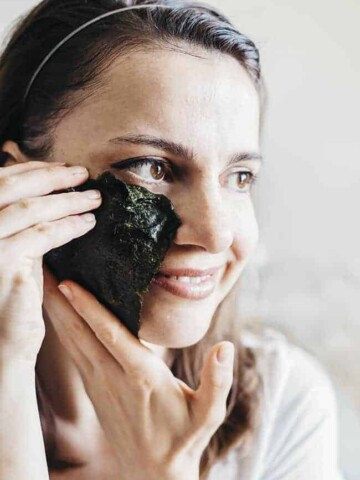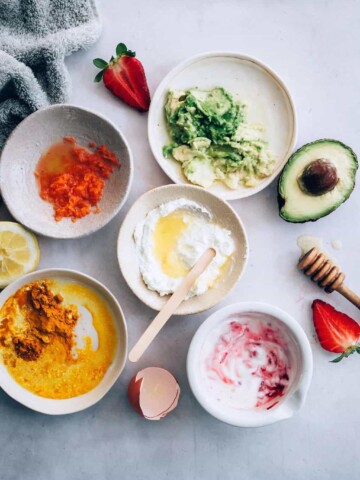Aloe vera is one of the best ingredients from nature, and this versatile skincare product should be a staple on everyone’s bathroom shelf. Both anti-inflammatory and cell-renewing, homemade aloe vera face mask recipes let your skin enjoy the goodness of nature.
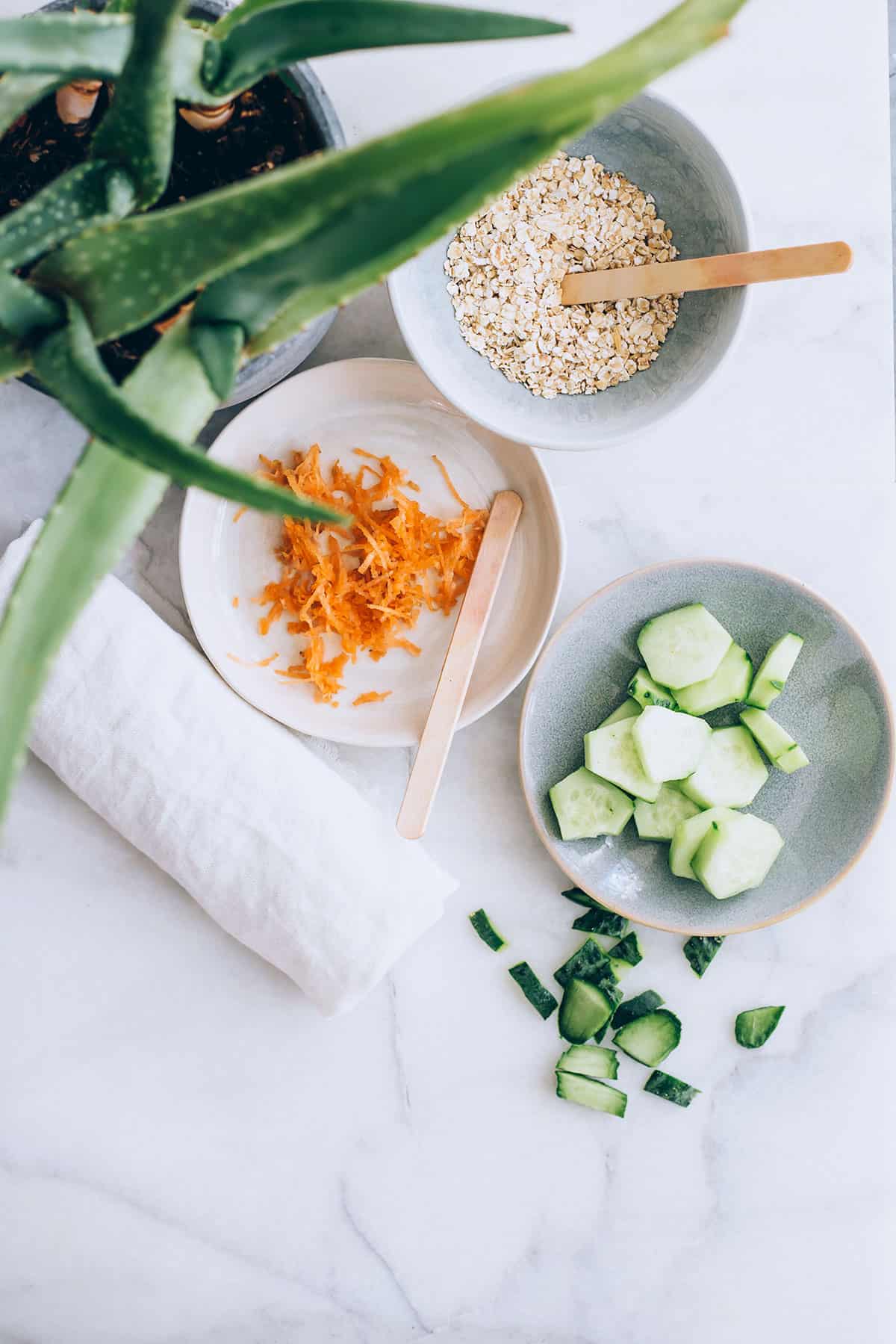
Jump to:
- 7 Homemade Aloe Vera Face Mask Recipes
- 1. Firming Aloe Vera Mask for Mature Skin
- 2. Antibacterial Aloe Vera Gel Face Mask for Acne-Prone Skin
- 3. Moisturizing Avocado and Aloe Vera Face Mask for Dehydrated Skin
- 4. Balancing Aloe Vera Mask for Oily Skin
- 5. Detox Aloe Mask for Clogged Pores or Irritated Skin
- 6. Brightening Face Mask for Hyperpigmentation
- 7. Antioxidant Aloe Mask for Aging Skin
- References
7 Homemade Aloe Vera Face Mask Recipes
Raw aloe vera gel contains over 75 naturally occurring biologically active compounds that benefit almost all parts of the body [source]—truly a wonder plant! They range from simple polysaccharides to powerful antioxidants and anti-inflammatories.
Aloe vera is a wonderful ingredient for all skin types. It is a highly moisturizing, hydrating gel, yet it doesn’t clog pores, so even the oiliest of skins can use it.
Its regenerative properties are beneficial for mature skin, and even sensitive skin will benefit from its anti-inflammatory properties.
1. Firming Aloe Vera Mask for Mature Skin

Carrots are a rich source of beta-carotene, a form of vitamin A that supports healthier, younger-looking skin. It’s a powerful antioxidant that protects the skin against environmental damage—specifically, the kind that you get from too much sun exposure and pollution over time [source].
You should use a regular carrot instead of the baby ones. Baby carrots lose some of their natural nutrients when they are turned into little nubs, while whole carrots are still packed full of all the things that are good for you, inside and out.
Plus, you can munch on the rest of the carrot as a perfect skin-nourishing snack while you’re waiting for your mask to dry!
- 1 egg white
- 1 tablespoon finely shredded carrot
- 1 teaspoon aloe vera gel
Combine egg white, carrot, and aloe vera in a small bowl. Beat the mixture together with a fork until frothy (about 1 minute).
With clean hands or a brush, apply the mask to the face and eye area. Let it dry for at least 15 minutes or up to 30 minutes. You may feel the mask tightening your skin, but if it gets uncomfortable before the time is up, go ahead and remove it with warm water.
2. Antibacterial Aloe Vera Gel Face Mask for Acne-Prone Skin
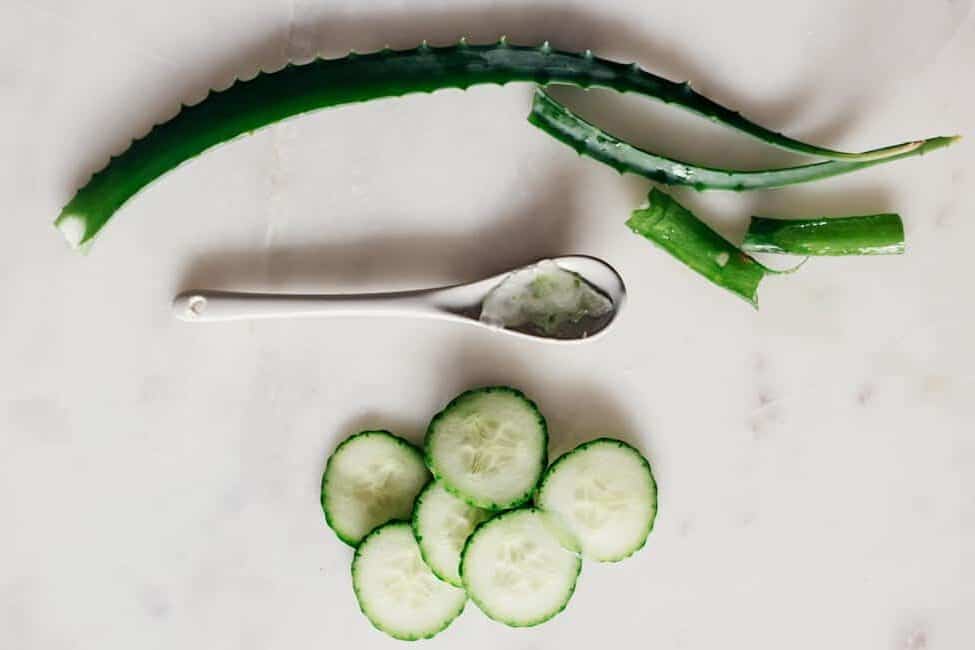
Tea tree essential oil is an amazing and highly potent skincare ingredient with the ability to do more than just banish acne. It’s antibacterial [source]—zapping zits by killing the acne-promoting bacteria.
Tea tree is also an anti-inflammatory [source], calming down skin that’s red and inflamed so that it’s a little less irritated. When combined with cucumber, another soothing and hydrating ingredient, this mask soothes angry skin in a jiffy.
- 4 tablespoon aloe vera gel
- 2 drops tea tree essential oil (more may be irritating, so don’t overdo it)
- ½ peeled cucumber
Blend all ingredients well and apply to the face with your fingertips or a facial brush. Leave it on for 10–15 minutes.
3. Moisturizing Avocado and Aloe Vera Face Mask for Dehydrated Skin
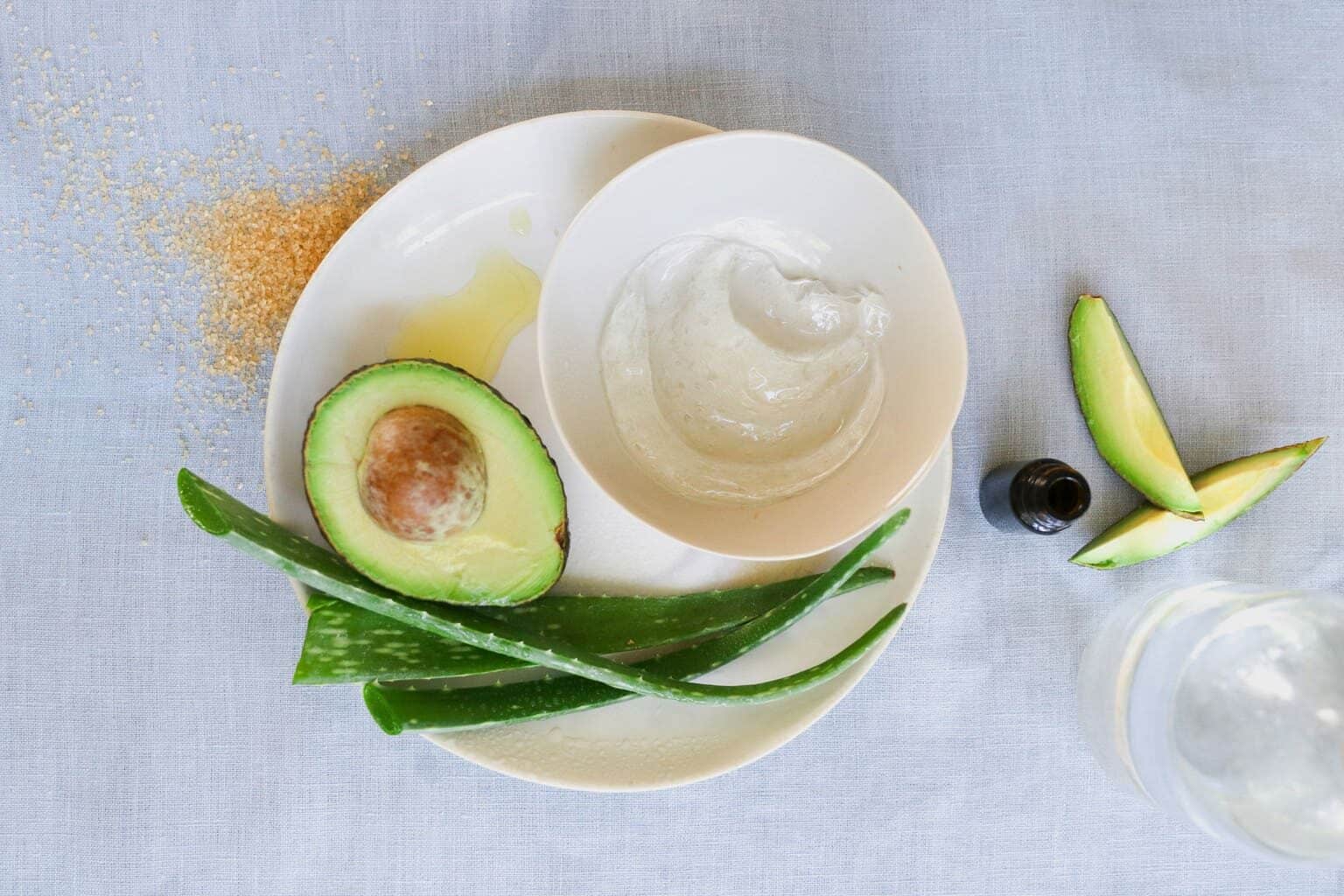
Avocado face masks are super soothing for dry, dehydrated skin. The healthy fats in avocado help maintain moisture in the epidermal layer of the skin, keeping it soft and supple, while the omega-3 fatty acids soothe inflammation, facial redness, and irritation [source]. Avocado oil has also been shown to increase collagen production when applied to the skin [source].
- ¼ mashed avocado
- 1 tbsp aloe vera gel
- 1 tablespoon organic oats
Combine mashed avocado with aloe and oats. Apply the mixture to your face, and leave it on for 10–15 minutes before rinsing with warm water. As you remove the mask, you can gently massage its remnants into your skin for a little exfoliation.
For a smoother mask, you can grind up the oats a little bit using a coffee grinder or food processor. This also helps ensure that your skin can make the most of its soothing abilities.
The compounds responsible for the incredibly nurturing power of oats are avenanthramides and beta-glucans. Avenanthramides are unique to oats and display unique anti-inflammatory, antioxidant, and anti-itch benefits to soothe skin [source].
Beta-glucans work as an intense hydrator, relieving dryness and promoting a healthy skin barrier. It also has anti-cancer, immune-stimulating, and wound-healing properties [source]. It’s no wonder entire skincare lines are based around oats—but who needs them when you can just use the real thing?
4. Balancing Aloe Vera Mask for Oily Skin
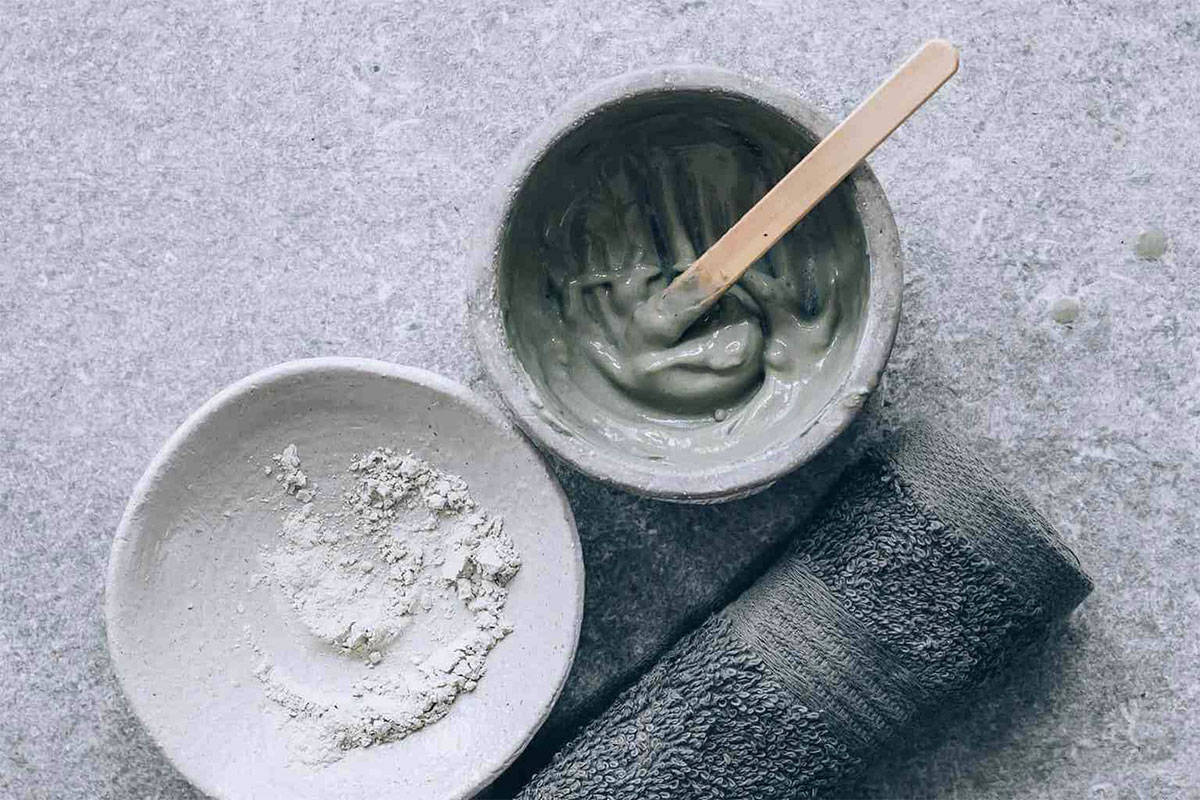
Most often recommended for balancing oily skin, white kaolin clay (China clay) is found in the soil in hot, moist climates. This particular type of clay is added to many beauty products, such as scrubs and deodorants, because of its drying effects.
Aloe vera, we have learned, moisturizes without clogging pores, which might be a concern for those with oily skin types.
- 2 tsp white kaolin clay
- 1 tsp aloe vera juice
- 1 teaspoon filtered water
Mix the ingredients in a ceramic bowl using a non-metal utensil, adding more water if the mask needs to be thinned out. Apply the mixture to your face, and allow 10–15 minutes to dry. Rinse with warm water and follow with moisturizer.
If you can’t get ahold of aloe vera juice, you can use fresh aloe vera or 99% aloe vera gelly.
5. Detox Aloe Mask for Clogged Pores or Irritated Skin
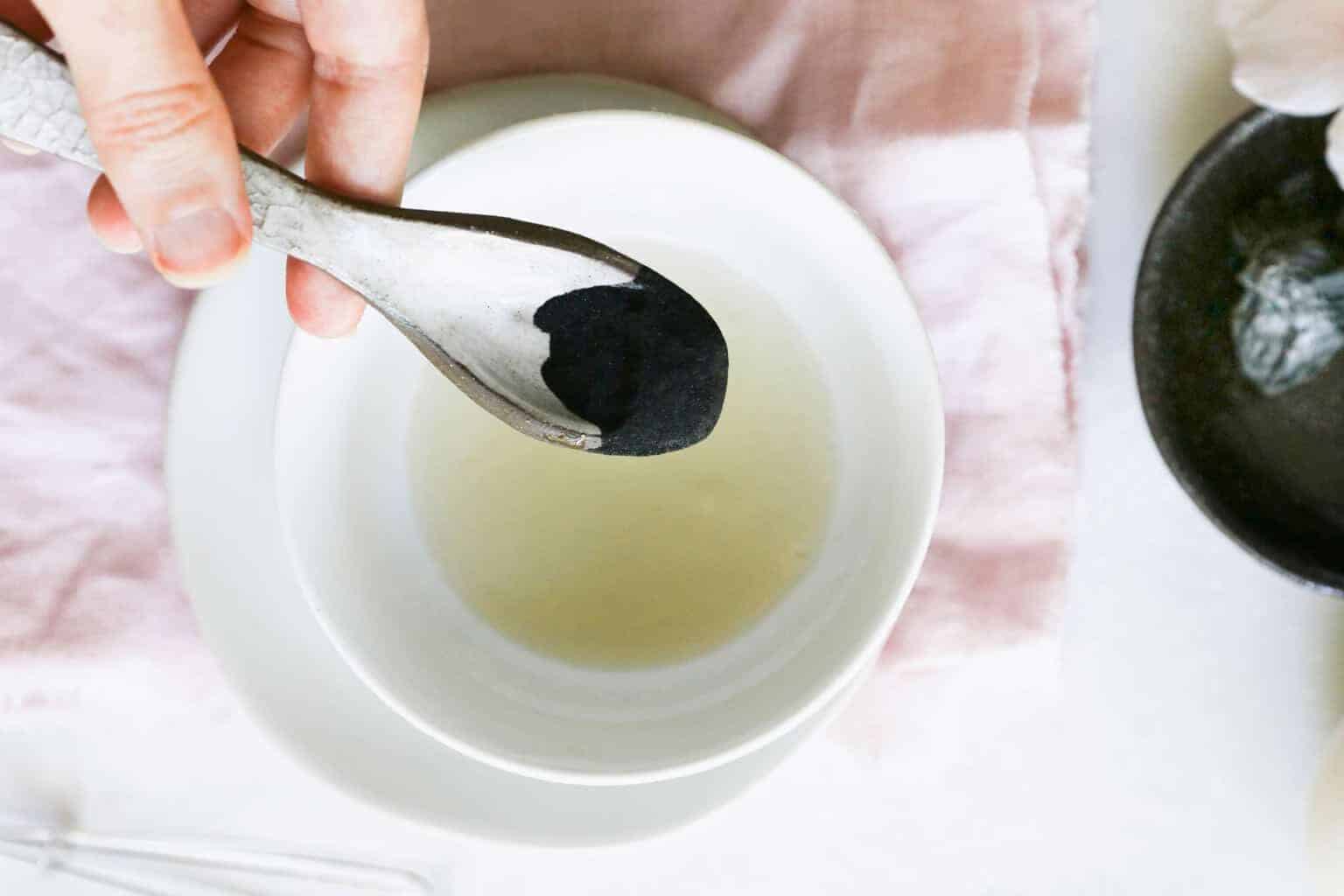
Combine charcoal with an aloe mask for a moisturizing treatment that won’t clog pores or send oily skin into overdrive. Aloe skin benefits also include faster healing and reduced inflammation [source], so you can also use this mask to soothe itchy, irritated, or dry skin.
Add the ingredients into a small bowl, and use your finger to mix them before applying to the skin. In circular motions, work the charcoal mixture around your face for 1 minute, then let the mask sit for 10–15 minutes. Rinse thoroughly with warm water.
6. Brightening Face Mask for Hyperpigmentation
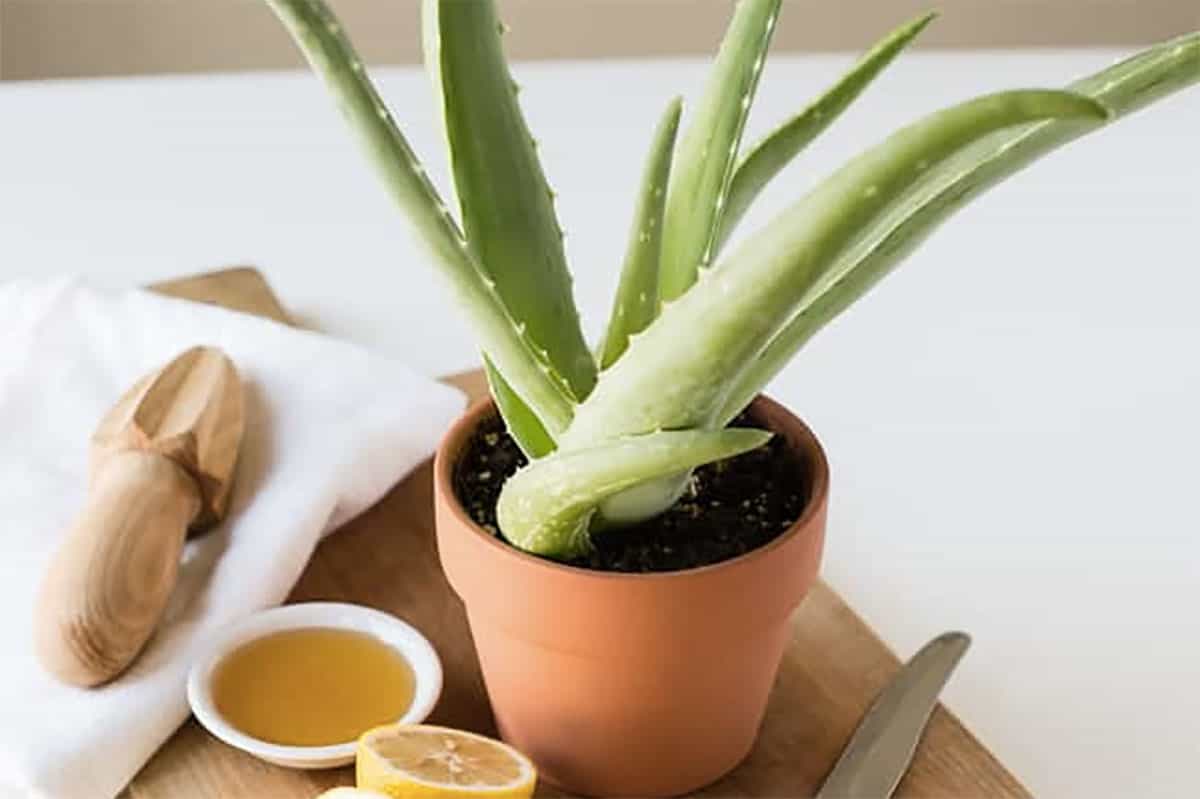
If you are looking for a brightening mask and possibly a light peel for your skin while also infusing some hydration, this aloe mask is just the ticket. Rich in vitamin C and antioxidants, lemons have many natural compounds that help ward off those damaging free radicals that contribute to aging skin [source].
Lemon juice is a natural exfoliant that can be used as a gentle peel for those top few layers of dead skin and to unclog pores.
- 1 tablespoon aloe vera gel
- Juice from ½ a lemon
- 1 tablespoon raw honey
Be sure this mask is applied at nighttime to prevent photosensitivity due to the citric acid in the lemon [source]. Mix all 3 ingredients well and apply to your face and neck evenly.
Leave the mask on for 5 minutes and then rinse thoroughly. This mask can be used once a month.
7. Antioxidant Aloe Mask for Aging Skin

The antioxidants in blueberries [source] brighten dull skin, while the coffee reduces puffiness.
- 3-6 strawberries or blueberries
- 1 teaspoon aloe vera gel
- ½ teaspoon finely ground coffee
Mash the blueberries in a small bowl, then add the aloe vera gel and ground coffee. Refrigerate for 1 hour. Gently apply the mixture to your face, avoiding the eye area, then rinse with warm water for 15 minutes.
Yes, fresh aloe vera gel can be used instead of commercial aloe vera gel in these recipes.
The frequency depends on your skin type and concerns. Once a week is generally suitable, but adjust based on your skin's response.
It's recommended to prepare these masks fresh for each application to ensure maximum effectiveness.
References
- Rahman S, et al. Aloe vera for tissue engineering applications. J Funct Biomater. 2017.
- Rinnerthaler M, et al. Oxidative stress in aging human skin. Biomolecules. 2015.
- Yasin M, et al. River tea tree oil: composition, antimicrobial and antioxidant activities, and potential applications in agriculture. Plants (Basel). 2021.
- Carson CF, et al. Melaleuca alternifolia (tea tree) oil: a review of antimicrobial and other medicinal properties. Clin Microbiol Rev. 2006.
- Dreher ML, et al. Hass avocado composition and potential health effects. Crit Rev Food Sci Nutr. 2013.
- Lin TK, et al. Anti-inflammatory and skin barrier repair effects of topical application of some plant oils. Int J Mol Sci. 2017.
- Perrelli A, et al. Biological activities, health benefits, and therapeutic properties of avenanthramides: from skin protection to prevention and treatment of cerebrovascular diseases. Oxid Med Cell Longev. 2018.
- Imran Bashir KM, et al. Clinical and physiological perspectives of β-glucans: the past, present, and future. Int J Mol Sci. 2017.
- Sánchez M, et al. Pharmacological update properties of Aloe vera and its major active constituents. Molecules. 2020.
- Klimek-Szczykutowicz M, et al. Citrus limon (lemon) phenomenon—a review of the chemistry, pharmacological properties, applications in the modern pharmaceutical, food, and cosmetics industries, and biotechnological studies. Plants (Basel). 2020.
- Kim K, et al. Phototoxicity: its mechanism and animal alternative test methods. Toxicol Res. 2015.
- Skrovankova S, et al. Bioactive compounds and antioxidant activity in different types of berries. Int J Mol Sci. 2015.
This post was medically reviewed by Dr. Jennifer Haley, a board-certified dermatologist with extensive experience in medical, cosmetic, and surgical dermatology. Learn more about Hello Glow’s medical reviewers here. As always, this is not personal medical advice, and we recommend that you talk with your doctor.
416
